ABSTRACT
This paper reviews the historical research that has led to widespread policies on compact urban form, in particular, residential development, and collates evidence that demonstrates that dispersed urban form may be more energy efficient than compact form. This is counterintuitive but is supported by both challenging the conventional modelling of energy use of buildings as well as case studies with empirical evidence. The conclusion is that policies on urban form should be driven not by existing technologies but by the disruptive technologies of the future. The increased use in distributed energy generation in urban areas (generally roof-mounted photovoltaics), the growth in ownership of electric vehicles and the potential introduction of smart and micro-grids and the possibility of virtual power plants is changing the impact that energy has on built form and conflicts with current policies for denser, contained and compact development.
Introduction
This article is focussed on energy as a determinant of built and urban form and challenges the idea that a compact urban form, particularly for residential buildings, is more energy efficient and the results can be applied almost universally. There are other reasons for compact urban form, such as the loss of agricultural land, cost of infrastructure or topographical reasons. However, these tend to be specific to a given location.
The energy use of a city is dependent on both transport and buildings (Steemers Citation2003; Rickwood, Glazebrook, and Searle Citation2008) in varying amounts depending largely on climate, energy technologies and urban form. Traditionally this has focussed on internal combustion engine vehicles (ICVEs) and the heat loss from the fabric of buildings. The assumption has been that the energy supply for both fuel and electricity is from a centralized network, rather than generated at point of use, and the logical conclusion of these assumptions has been that a compact city will consume less energy than a dispersed city because travel distances will be less (Newman and Kenworthy Citation1989a; Guhathakurta and Williams Citation2015) and buildings will use less energy as there is a reduced ratio of surface area to volume of the building fabric where energy flows from (Ewing and Rong Citation2008; Joiner Citation2010; Rode et al. Citation2014).
As a result, compact urban areas, in particular for residential development, have been extensively promoted (Breheny Citation1995) as low energy consumers and this has been adopted as a criteria for ‘smart cities’ (Albino, Berardi, and Dangelico Citation2015). This impacts on urban form since compactness requires containment at the peripheries that tends to result in built forms of greater height. Therefore, urban form has two basic shapes: compact cities tend to go ‘up’ while dispersed cities go ‘out’. Cities that go ‘up’ generally have a higher population density than cities that go ‘out’ (sprawl). There are secondary considerations for urban form that impact on energy use such as the density of sprawl, residential building types, the proximity of tall buildings to each and whether a city is mono or polycentric. However, these have a lesser influence on energy used by buildings compared with the fundamentals of ‘up’ or ‘out’.
It should be noted that the case studies on housing in the different countries that are discussed below, compare energy use with heights of residential buildings. The studies do not compare energy with density. This is an area that requires further investigation, but is an area that is fraught with problems since greater density can be achieved by reducing housing unit sizes. ‘Up’ or ‘out’ has an implicit assumption that residential unit sizes will be approximately the same in both cases. However, relatively high density can be achieved with medium rise, compact buildings and further evidence on energy use of large samples of these buildings is required.
Intuitively, these arguments for a compact urban form appear logical. Reducing travel distances results in a reduction of fuel consumption and reducing the surface area to volume ratio of a building reduces heat loss and hence energy use from buildings. Combined, these two arguments present a robust case for introducing policies concerning compact urban form.
However, there is emerging evidence that this is not necessarily the case and that a dispersed urban form may be more energy efficient. This paper reviews both the historical research supporting compact urban form policy and also reviews more recent research that is indicating the opposite.
The case against compact buildings is essentially twofold. Firstly, that surface area to volume ratio is no longer a good index of energy use in a building. This is based on an increase in insulation standards, bias assumptions in the modelling of energy use and a shift in energy use within buildings towards more electrical appliances (Lomas Citation2010). Secondly, the increasing relevance and evidence of energy used in common areas of compact buildings (Finch, Burnett, and Knowles Citation2010; Heinonen and Junnila Citation2014) that results in higher energy use by compact buildings.
This evidence is now supported by empirical evidence of actual energy use from large samples of different building types from both warm and cold climates (Heinonen and Junnila Citation2014; Myors, O’leary, and Helstroom Citation2005). However, when the possibility of generating energy on a roof with photovoltaics (PVs) is taken into account, the net energy flow in a residential building favours non-compact building types with a large roof to floor area ratio: detached buildings trump apartments.
The importance of research on large samples of housing is that the results tend to be less distorted due to the social effects on energy use. For example, energy use is not only related to the characteristics of a building but also to household income, occupancy patterns and comfort standards. The larger the sample for a given building type, the more likely the energy use results reflect the characteristics of built form (Hildon and Byrd Citation1984).
The case against compact urban form due to transport energy use is based on the introduction and widespread growth of electric vehicles (EVs). EVs are significantly more energy efficient than ICVEs but the energy use (and carbon production) is dependent on how they are charged. If they are charged by PVs mounted on residential roofs, then the energy is comparatively clean and free. Furthermore, smart grids and micro-grids allow for the energy generated to be directed away from the home so that a vehicle need not be at the point of generation in order to benefit. Alternatively, the energy could be directed towards electrically powered public transport.
When these disruptive technologies are taken into account, both energy use by buildings and transport favour lower density, non-compact urban form. Therefore, it is argued that policy on urban form should be based on the technologies of the future rather than the past.
Throughout the following text, there are figures that all relate energy (y-axis) to an index of urban form (x-axis): building height (as a measure of ‘up’) and urban density (as a measure of ‘out’). The figures are indicative only and the importance is in the relative, rather than absolute, values. Hence the units of measurement and values are not included. However, the absolute values can be obtained by referring to the body of work that is cited in the respective figure captions.
Energy and the shape of buildings: limitations in modelling
Early research into energy and built form (March Citation1972; Rickaby Citation1987; Steadman and Brown Citation1987) related energy use of buildings to the ratio of surface area: volume of buildings. Since heat loss from a building is proportional to its surface area and respective material heat flow properties (U-values), optimization of built form focussed on minimizing the ratio of surface area to volume ratio resulting in compact built form (Steemers Citation2003). Although Steadman, Evans, and Batty (Citation2009) note that there should be a maximum threshold for building depth in order to avoid artificial ventilation and lighting that is required once the depth of rooms exceed the ‘passive zone’.
The assumption that heat loss from the envelope is the most relevant index of energy performance has prevailed over time. For example, almost 40 years after March’s ‘elementary model of Built Form’ (Citation1972), Joiner (Citation2010) in an argument for urban intensification, suggested that, ‘By joining houses together or otherwise clustering them, the external envelope of each house can be reduced, with consequent reductions in heat losses.’
The logical conclusion of this assumption is that housing is more energy efficient if its built form is compact and, given its requirements for natural ventilation and daylight, this will necessarily mean that more vertical forms (high-rise apartments) are more energy efficient than detached houses.
This was the basis of research (Rode et al. Citation2014) on the relationship between the form of cities and residential heat demand. The results appeared to provide evidence, as well as recommending policy, that tall buildings are an optimum shape due to their relatively low surface to volume ratio and, hence, heat losses.
The results were calculated using the standard heat loss model of E∝∑(Ui·Ai) (where E is the heat loss, U is the envelope material U-values and A is the respective area of the envelope materials). However, this type of analysis becomes a self-fulfilled prophecy that a low surface area: volume ratio will be the optimum since the U-values were kept constant in the analysis. The result, adapted from Rode et al. (Citation2014), is conceptually illustrated in Figure and indicates an almost inverse-square law. Their results indicated that a two-storey building typically has a heat loss of twice that of a ten storey building.
Figure 1. Indicative trend of energy consumption for space heating by increasing the number of storeys. Adapted from Rode et al. (Citation2014).
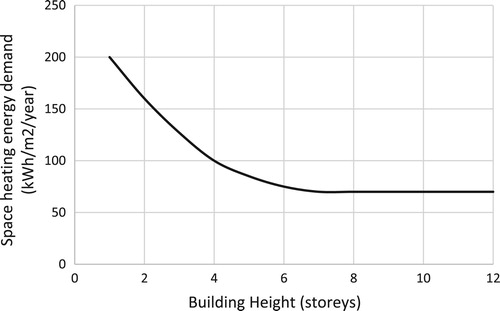
However, there are a number of assumptions that undermine the results of this research. Firstly, the U-values of the existing buildings were outdated and up to 8 times worse than U.K. building regulations (a minimum legal requirement). This has a profound effect on modelling since, as insulation standards increase, the relative amount of energy used for heating decreases. Hypothetically, as an extreme example, if a material could be found which does not allow heat to flow through it, then surface area, and hence shape of a building, would not be relevant.
Secondly, the assumption that all building typologies (apartments or detached and types between) have the same elevational proportion of glazing, skews the results. For a fair comparison, the same size living unit (apartment of detached) has the same daylighting needs and should have the same area of glazing. Assuming that the amount of glazing should be proportional to the exposed external wall area can result in about twice as much glass in a detached building.
Added to this is the assumption that there is no heat transfer between adjacent properties in a multi-unit development. Unoccupied units, partial heating and variations in set temperatures all result in greater heat losses from compact housing that does not occur in detached housing.
However, by compacting housing into blocks, another aspect of energy use becomes more prominent: the heating, lighting and servicing of communal spaces. Lighting and heating corridors, machinery for lifts, ventilation and lighting for car parks, external lighting, mechanical ventilation, pumps, illuminated signage and others amount to a significant energy use. Assessments of these have ranged between about 10% of overall energy use (when heating is included) (Ho Citation2012) to about 20% (Finch, Burnett, and Knowles Citation2010) in colder climates.
Furthermore, over time the insulation standards of building fabric have increased and an increasing proportion of energy is now used for household appliances and entertainment (Lomas Citation2010). This begins to challenge the idea that fabric heat loss is a representative indicator of a building’s whole energy usage, particularly building types with communal areas. When all the above assumptions are adjusted (U-values, % glazing, heat transfer between units and energy use in common areas) modelling results indicates virtually no correlation between built form and energy use (Figure ).
Figure 2. Relative energy use compared to building height for the original research (Figure ) and recalculated to include upgraded insulation standards and energy use in common areas.
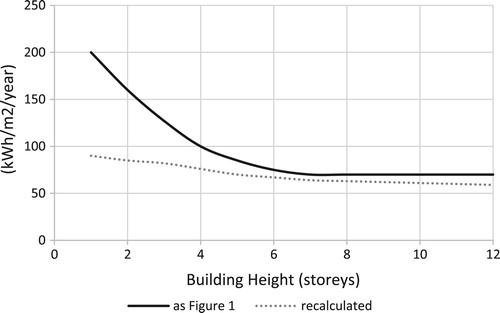
Assumptions in the modelling of energy use can significantly distort the outcome. However, empirical data from a large sample has greater relevance than theory and gives a more reliable picture. This was demonstrated in a report by Myors, O’leary, and Helstroom (Citation2005) which analysed, using actual energy records, the energy use of a sample of 3854 house of differing types in Sydney, Australia (sub-tropical climate). The results showed that, when energy use in common areas and for common services are taken into account, high-rise can be the least energy efficient building typology, leaving detached buildings as more energy efficient.
This is indicated in Figure and the results, being empirical rather than theoretical, from such a large sample upset the idea that compact (high-rise) built form is more energy efficient. The results of the Sydney study, based on actual energy readings, indicate almost exactly the opposite to the ‘Cities and Energy’ study (Rode et al. Citation2014) (Figure ) which was based on modelling. While the building typologies considered are not exactly the same in the studies, and the climate in Sydney is generally warmer than the European climate, the difference in the results is emphatic.
Figure 3. Relative energy consumption in different building types (empirical results from Sydney). Adapted from Myors, O’leary, and Helstroom (Citation2005).
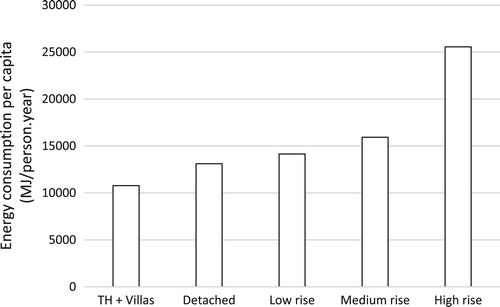
However, climate may not have such a significant impact since similar research in Finland’s sub-arctic climate (Heinonen and Junnila Citation2014), again based on actual energy use, also identified the same characteristic: detached houses using less overall energy than apartments on a per capita occupancy basis to normalize of building size (Figure ).
Figure 4. Average per capita energy use in different building types. Adapted from Heinonen and Junnila (Citation2014).
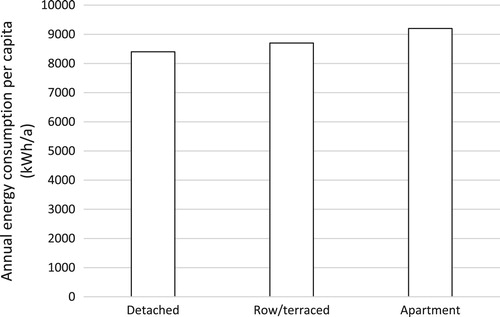
A similar result was also identified by research (Hamilton et al. Citation2017) on actual energy use on a large sample of London’s housing stock in U.K. (temperate climate) which concluded that high-rise buildings are more energy-intensive than low-rise buildings, ‘much energy could be saved by discouraging tall buildings and encouraging low-rise in their place’.
The impact of renewable energy on built form
Since the significant uptake of PVs on the roofs of houses, analysis of optimum built forms for reducing energy use now needs to consider not only energy losses from buildings but also energy generated by PVs on those buildings. The important criterion for generating energy becomes the area of PV array (the area being proportional to energy generation) that can be installed on a roof and, in order to compare the merits of different built forms, the ratio of PV area to floor area (floor area being an index of energy consumption).
For example, Cheng et al. (Citation2011) identified that ‘medium to low density housing may in some cases enable a greater saving in CO2 emissions than higher density development because of the greater amount of space for collection of renewable energy’.
Not only do lower housing densities result in better solar access for PVs, compact development reduces solar access for both PVs and passive solar gains. For example, research by Mohajeri et al. (Citation2016) observed that, ‘When passing from dispersed to compact neighborhoods, the BIPV (building integrated photovoltaics) potential for facades decreases from 20% to 3%, whereas for roofs the BIPV potential decreases from 94% to 79%’.
High-rise is not only disadvantaged because of mutual shading that reduces passive heat gains but also because the effective roof area is small compared to the floor area beneath. Whereas low-rise buildings have a high roof area to floor area ratio and can provide a significant amount of electricity for their own needs.
This was demonstrated in research on a cross-section of building types across a city (Byrd et al. Citation2013). The energy generated by PVs on a building was compared with energy consumption of various built forms. While there is some potential for PVs to be mounted on non-residential buildings, suburban housing offered the greatest potential for PVs. This is indicated in Figure which illustrates a cross-section through Auckland (NZ) and both the energy generated and consumed as a bar chart below (negative values indicate energy generated). Low-density, low-rise buildings in the suburbs not only produce enough energy for their own use but also produce an excess that can be exported. Conversely, high-rise consumes considerably more energy than it produces.
Figure 5. Comparing the potential energy generated from PVs with the energy consumed by the building. Adapted from Byrd et al. (Citation2013).
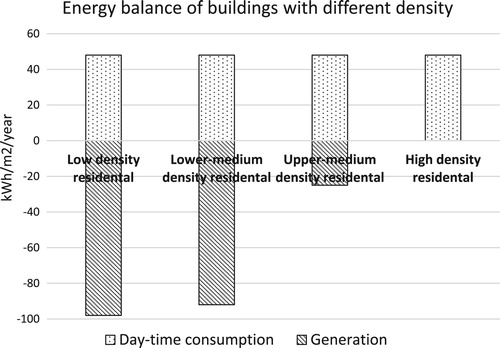
The net energy balance when urban areas have extensive energy generation from rooftop PVs varies from a considerable surplus in low-density suburbia to an emphatic deficit in high-density areas.
Other studies have also demonstrated that in addition to solar energy, other types of renewable energy sources such as ground sourced heat pumps (Echenique et al. Citation2012; Hargreaves et al. Citation2017) as well as biomass (Ghosh, Vale, and Vale Citation2006) also have higher potential in lower density urban development.
Optimum built form for reducing energy consumption
The evidence above, based on actual energy use, indicates that, irrespective of climate, urban form that goes ‘up’ (apartments) is likely to result in greater energy consumption than urban form that goes ‘out’ (detached). Modelling energy use of urban form on the basis of ratio of surface area to volume alone is no longer an accurate indicator of energy use by buildings. However, when energy generated by PVs is taken into account, low-rise housing is more energy efficient. Decentralized energy generation on rooftops combined with its efficient distribution through ‘feed-in’ to the main grid or to micro-grids results in low-density, low-rise housing becoming a more energy efficient built form (IEA Citation2009). Increasing urban density not only reduces the contribution of solar energy (Margalit Citation2016), but can also result in greater energy consumption.
The proportion of energy used for heating and cooling as well as the energy generated by PVs will vary depending on climate. However, the overall trend is a gradual warming and research in the U.K. (Lomas Citation2010) has indicated that for every 1°C average warming, the national energy consumption by housing will decrease by about 6%. In temperate climates, considering the fabric heat loss to be an indicator of the energy performance of a building is becoming an ever cruder method of analysing the impact of built form on energy consumption as average temperatures rise.
Energy and transportation
Research into the relationship between energy use and urban density was intensified after Newman and Kenworthy’s (Citation1989b) publication that graphically illustrated an almost inverse-square relationship between energy use (e) and density (d) such that e proportional 1/dn as illustrated in Figure .
Figure 6. Gasoline use per capita versus population density. Adapted from Newman and Kenworthy (Citation1989a).
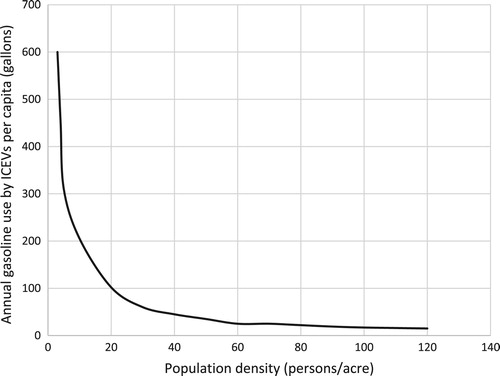
This research has had some criticism. For example, the difference in fuel prices between the cities were not considered (Gomez-Ibanez Citation1991) and that it assumes a mono-centric city form (Gordon, Richardson, and Jun Citation1991). It has also been criticised by Breheny (Citation1995) who suggests that the evidence of transport energy use does not support the theory of the inverse-square relationship proposed by Newman and Kenworthy:
Over the last 30 years decentralization has made a trivial contribution to additional energy consumption, implying that efforts to prevent further decentralization – if successful, which is doubtful - will also be trivial in their effect.
More recent research on the relationship of transport energy and urban density has considered the use of EVs powered by decentralized energy supplies (Byrd Citation2017). Based on data on existing vehicle travel patterns combined with potential solar energy available on rooftops, it is possible to calculate the extent to which electricity from PVs can displace hydrocarbon-based fuels. However, it should be noted that this research was based on a high penetration of PVs that is more likely to occur after the middle of this century.
The research identified that there is an inverse correlation between urban density and transport energy. That is to say that residential roof-mounted PVs in lower density urban areas can potentially generate more energy than is required for typical transport needs in urban areas. Suburbia can effectively power transport in a city and still have energy spare. This does not necessarily mean that the vehicles need to stay at home to be charged. There are various options of distributing renewable energy that is generated by distributive means including the possibility of peer to peer or micro-grids (REN21 Citation2017). The future use of virtual power plants (VPPs) will also make it possible to utilise energy stored throughout an urban area to be directed towards electrically powered public transport (Niconowicz and Milewski Citation2012).
This is the exact opposite relationship of energy and built form that Newman and Kenworthy (Citation1989) have proposed; such that e proportional –1/dn. This is illustrated in Figure . While EVs have not penetrated the market to that extent as yet, the graph indicates a more likely future than a continued reliance on fossil fuel for transport.
Figure 7. Comparison of transportation energy consumption in case of using ICVEs and EVs. Adapted from Byrd et al. (Citation2013).
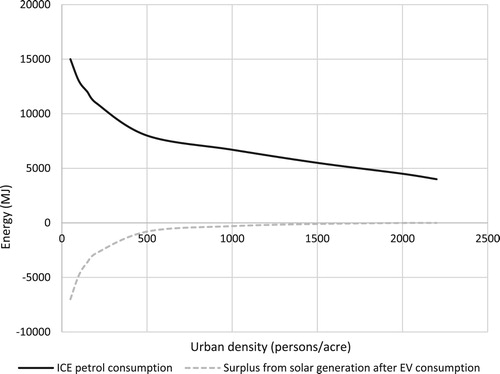
Discussion and limitations
In the introduction, the impact of climate on building energy consumption was mentioned, but needs still further consideration. The evidence that compact built form consistently performs worse over differing climates does not necessarily mean that climate is not a factor. A more likely reason, requiring further investigation, is that the insulation standards are higher in countries with colder climates.
Nevertheless, the case studies mentioned above in Australia (sub-tropical), Finland (sub-arctic) and the U.K. (temperate) have contrasting climates but broadly similar results that do not favour compact buildings. However, solar energy availability will vary considerably between these climates.
Climate change will also have an impact with average temperatures likely to continue to rise resulting in less heat loss in colder climates, more overheating in warmer climates and consequent increased use of air-conditioning. The combination of increasing internal heat gains, inadequate design for solar protection or natural ventilation, continued climate change as well as market forces promoting air-conditioning, has led to a shift in energy use from winter to summer in temperate climates (Byrd Citation2012).
While this could be partially addressed by improved design of buildings, it tends to be multi-unit and high-rise buildings that do not shade fenestration or allow for cross-ventilation. The impact of this was highlighted in research in warmer climates (Mandal and Byrd Citation2017) and it is not unreasonable to speculate that air-conditioning will spread further in urban areas in temperate climates as average temperatures increase. Therefore, it is likely that this new electricity load in temperate climates will be driven by compact building types.
A further important argument that is relevant to the relationship of energy and urban form is that of ‘resilience’; in particular mitigating the impact of electricity blackouts. Tall buildings are inherently more vulnerable to electricity blackouts. Pumps, lifts, emergency lighting and security systems can make this building type almost uninhabitable in a blackout (Byrd and Matthewman Citation2014). Whereas building types that are low-rise and have reasonable roof to floor area ratio are less vulnerable and, with self-generation of electricity, can become partially autonomous for energy supply.
The argument for compaction of urban form in order to minimize impact on agricultural land is also an area requiring further research. Not all land is suitable for crop growth and some forms of agricultural production have adverse environmental impacts. For example, in New Zealand (where compact urban form is partially argued on grounds of loss of productive land) recent statistics (Ministry for the Environment Citation2018) have shown that urban growth is only 2.6% that of the growth of dairy land (with significant adverse impacts) and 5.9% of the area of land given to ‘lifestyle blocks’ (non-commercial hobby farms for the elite). While the impact of urban form on energy is reasonably universal, the issues around land use are local.
Another important issue is the rate at which new technologies will impact on urban form. Disruptive technologies are introduced and evolve over a matter of years while urban form may take decades or centuries to adapt. The evidence that is beginning to be revealed about the relationship between urban form and disruptive technologies is unlikely to have a significant impact on established urban form but is an important contribution to planning policy for new developments and the continuing debate of the compaction of cities.
The impact of disruptive technologies is relatively recent and, until they are more widely distributed and adopted within the built environment, caution should be taken in extrapolating the results. However, what the results are showing so far is that previous compact- city theory needs to be reviewed and that radical changes may be required to policy.
Conclusion
The fundamental discussion of the relationship between urban form and energy is concerned with compaction: compaction of individual buildings (‘up’) and compaction of the spread of buildings (‘out’). Intuition, combined with previous research results has indicated that buildings with a low ratio of surface area to volume lose less heat and that containment of urban spread (sprawl) results in less transport energy. The simple conclusion from this is that ‘up’ is better than ‘out’ for reducing energy consumption.
Subsequent research reviewed in this paper has demonstrated that heat loss from building fabric is not a good indicator of whole-building energy use. When other factors are accounted for (common area energy use, occupancy, energy use for non-space heating) the correlation between built form and energy use is shown to be weak. Case studies in different climates using actual energy data have indicated that compact (tall) buildings perform worse than low-rise buildings. Furthermore, when energy generated on a building is taken into account, the net energy balance of a building strongly favours low-rise buildings rather than compact high-rise.
Research on the relationship between transport energy and urban form has focussed on vehicles with internal combustion engines. Again, the conclusion of this is that urban form should not go ‘out’ but should be contained by going ‘up’. However, as car manufacturers shift production to EVs combined with incentives to assist purchase, these vehicles are likely to dominate the market in years to come. It is a relatively simple thing to then charge these vehicles from electricity generated on rooftops.
The result is that suburbia becomes a net energy generator and that travel distance within an urban area has little impact on resource depletion or carbon production. The future use of VPPs will also make it possible to utilize energy stored throughout an urban area to be directed towards electrically powered public transport.
One of the main reasons for this counterintuitive result is the influence of disruptive technologies. The distributed generation of electricity that has the possibility of being directed towards the charging of EVs, for private or public use, changes the assumptions previously made in this field of research.
Current policies on compaction of urban areas have been influenced, among other things, on research that has not taken account of these technological changes. The shape of urban areas of the future should not be determined by the technologies of the past but by the technologies of the future. However, the trends illustrated in this article are long term and, in developed countries, changes in building stock are slow and technologies may change even faster. This highlights the need for continued research in this field and to challenge those intuitive assumptions that persist.
Disclosure statement
No potential conflict of interest was reported by the authors.
Additional information
Funding
References
- Albino, V., U. Berardi, and R. M. Dangelico. 2015. “Smart Cities: Definitions, Dimensions, Performance, and Initiatives.” Journal of Urban Technology 22: 3–21. doi: 10.1080/10630732.2014.942092
- Breheny, M. 1995. “The Compact City and Transport Energy Consumption.” Transactions of the Institute of British Geographers 20: 81–101. doi: 10.2307/622726
- Byrd, H. 2012. “The Case for Policy Changes in New Zealand Housing Standards due to Cooling and Climate Change.” Journal of Environmental Policy & Planning 14: 360–370. doi: 10.1080/1523908X.2012.719693
- Byrd, H. 2017. “The Power of Suburbia.” In Infinite Suburbia, edited by A. Berger, J. Kotkin, and C. B. Guzman, 604–614. New York: Princeton Architectural Press.
- Byrd, H., A. Ho, B. Sharp, and N. Kumar-Nair. 2013. “Measuring the Solar Potential of a City and Its Implications for Energy Policy.” Energy Policy 61: 944–952. doi: 10.1016/j.enpol.2013.06.042
- Byrd, H., and S. Matthewman. 2014. “Exergy and the City: The Technology and Sociology of Power (Failure).” Journal of Urban Technology 21: 85–102. doi: 10.1080/10630732.2014.940706
- Cheng, V., S. Deshmukh, A. Hargreaves, K. Steemers, and M. Leach. 2011. “ A Study of Urban Form and the Integration of Energy Supply Technologies.” In World Renewable Energy Congress-Sweden, Linköping, Sweden, May 8–13, 3356–3363. Linköping University Electronic Press.
- Echenique, M. H., A. J. Hargreaves, G. Mitchell, and A. Namdeo. 2012. “Growing Cities Sustainably: Does Urban Form Really Matter?” Journal of the American Planning Association 78: 121–137. doi: 10.1080/01944363.2012.666731
- Ewing, R., and F. Rong. 2008. “The Impact of Urban Form on US Residential Energy Use.” Housing Policy Debate 19: 1–30. doi: 10.1080/10511482.2008.9521624
- Finch, G., E. Burnett, and W. Knowles. 2010. “Energy Consumption in Mid and High Rise Residential Buildings in British Columbia.” Building Enclosure Science & Technology (BEST2) Conference, Portland, Oregon.
- Ghosh, S., R. Vale, and B. Vale. 2006. “Domestic Energy Sustainability of Different Urban Residential Patterns: A New Zealand Approach.” International Journal of Sustainable Development 9: 16–37. doi: 10.1504/IJSD.2006.010936
- Gomez-Ibanez, J. A. 1991. “A Global View of Automobile Dependence.” Journal of the American Planning Association 57: 376–378.
- Gordon, P., H. W. Richardson, and M.-J. Jun. 1991. “The Commuting Paradox Evidence from the Top Twenty.” Journal of the American Planning Association 57: 416–420. doi: 10.1080/01944369108975516
- Guhathakurta, S., and E. Williams. 2015. “Impact of Urban Form on Energy Use in Central City and Suburban Neighborhoods: Lessons from the Phoenix Metropolitan Region.” Energy Procedia 75: 2928–2933. doi: 10.1016/j.egypro.2015.07.594
- Hamilton, I., S. Evans, P. Steadman, D. Godoy-Shimizu, M. Donn, H. Shayesteh, and G. Moreno. 2017. “ The energy implications of building tall cities.” CISBAT 2017 international conference, Lausanne Switzerland, September.
- Hargreaves, A., V. Cheng, S. Deshmukh, M. Leach, and K. Steemers. 2017. “Forecasting how Residential Urban Form Affects the Regional Carbon Savings and Costs of Retrofitting and Decentralized Energy Supply.” Applied Energy 186: 549–561. doi: 10.1016/j.apenergy.2016.02.095
- Heinonen, J., and S. Junnila. 2014. “Residential Energy Consumption Patterns and the Overall Housing Energy Requirements of Urban and Rural Households in Finland.” Energy and Buildings 76: 295–303. doi: 10.1016/j.enbuild.2014.02.079
- Hildon, A., and H. Byrd. 1984. The Better Insulated House Programme. Technical Report. Department of the Environment. Accessed September 2018. http://eprints.lincoln.ac.uk/31115/.
- Ho, A. 2012. Energy Efficient Suburbia-Transforming the Perceived Oxymoron: A Case Study of the Impact of Smart Energy Technologies on Urban Form in Auckland, New Zealand. Auckland: University of Auckland.
- IEA. 2009. Cities, Towns and Renewable Energy: Yes in My Front Yard. Paris: OECD Publishing. doi:10.1787/9789264076884-en.
- Joiner, D. 2010. “ Sustainable Urban Behaviour.” In New Zealand Sustainable Building Conference SB10. Wellington: Department of Building and Housing.
- Lomas, K. J. 2010. “Carbon Reduction in Existing Buildings: A Transdisciplinary Approach.” Building Research & Information 38: 1–11. doi: 10.1080/09613210903350937
- Mandal, A., and H. Byrd. 2017. “Density, Energy and Metabolism of a Proposed Smart City.” Journal of Contemporary Urban Affairs 1: 57–68. doi: 10.25034/ijcua.2017.3648
- March, L. 1972. “Elementary Models of Built Forms.” In Urban Space and Structures, edited by L. Martin, and L. March, 55–96. Cambridge: Cambridge University Press.
- Margalit, H. 2016. Energy, Cities and Sustainability: An Historical Approach. London: Routledge.
- Ministry for the Environment. 2018. “ Our Land.” Accessed June 2018. http://www.mfe.govt.nz/publications/environmental-reporting/our-land-2018.
- Mohajeri, N., G. Upadhyay, A. Gudmundsson, D. Assouline, J. Kämpf, and J.-L. Scartezzini. 2016. “Effects of Urban Compactness on Solar Energy Potential.” Renewable Energy 93: 469–482. doi: 10.1016/j.renene.2016.02.053
- Myors, P., R. O’leary, and R. Helstroom. 2005. “ Multi Unit Residential Buildings Energy & Peak Demand Study.” Accessed March 2018. https://www.ausgrid.com.au/-/media/Files/Network/Demand-Management/Energy-use-resources/Networks_multi_unit_sumrep_Oct08.pdf.
- Newman, P. G., and J. R. Kenworthy. 1989a. Cities and Automobile Dependence: An International Sourcebook. Brookfield: Gower Publishing.
- Newman, P. W., and J. R. Kenworthy. 1989b. “Gasoline Consumption and Cities: A Comparison of US Cities with a Global Survey.” Journal of the American Planning Association 55: 24–37. doi: 10.1080/01944368908975398
- Niconowicz, L., and J. Milewski. 2012. “Virtual Power Plants-General Review: Structure, Application and Optimisation.” Journal of Power Technologies 92 (3): 135–149.
- REN21. 2017. Renewables Global Futures Report: Great Debates Towards 100% Renewable Energy. Renewable Energy Policy Network.
- Rickaby, P. A. 1987. “An Approach to the Assessment of the Energy Efficiency of Urban Built Form.” In Energy and Urban Built Form, edited by D. Hawkes, J. Owers, P. Rickaby, and P. Steadman, 43–61. London: Butterworth-Heinemann.
- Rickwood, P., G. Glazebrook, and G. Searle. 2008. “Urban Structure and Energy – a Review.” Urban Policy and Research 26: 57–81. doi: 10.1080/08111140701629886
- Rode, P., C. Keim, G. Robazza, P. Viejo, and J. Schofield. 2014. “Cities and Energy: Urban Morphology and Residential Heat-Energy Demand.” Environment and Planning B: Planning and Design 41: 138–162. doi: 10.1068/b39065
- Steadman, P., and F. Brown. 1987. “Estimating the Exposed Surface Area of the Domestic Stock.” In Energy and Urban Built Form, edited by D. Hawkes, J. Owers, P. Rickaby, and P. Steadman, 113–131. London: Butterworth-Heinemann.
- Steadman, P., S. Evans, and M. Batty. 2009. “Wall Area, Volume and Plan Depth in the Building Stock.” Building Research & Information 37: 455–467. doi: 10.1080/09613210903152531
- Steemers, K. 2003. “Energy and the City: Density, Buildings and Transport.” Energy and Buildings 35: 3–14. doi: 10.1016/S0378-7788(02)00075-0
